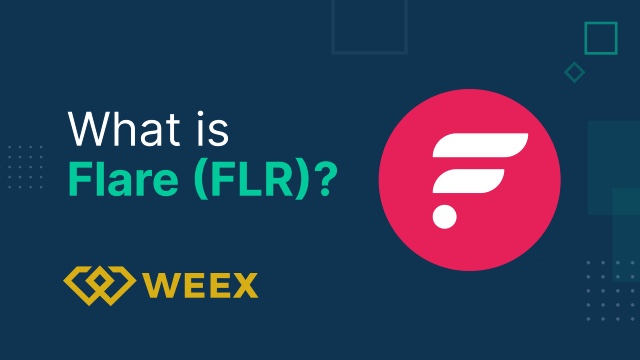Flare (FLR) is an EVM (Ethereum Virtual Machine) based interoperative blockchain that enables using smart contracts on the XRP network. The native currency used for this is the Flare token (FLR). Flare has been developed to form an interoperative blockchain, which means that it‘s now possible for multiple blockchains to communicate with each other. Where previously you were not able to use Ethereum smart contracts on the XRP network, this is now possible thanks to the Flare network.
The Flare network uses two protocols: the State Connector and the Flare Time Series Oracle (FTSO). The State Connector protocol ensures that data from outside the blockchain can be used securely within the chain, such as general information or information about a transaction. The Flare Time Series Oracle is a smart contract that runs on the Flare network and through continuous calculations forms a source of reliable off-chain data for use on the network. This is done in a decentralized and secure manner, so there is no party that has the upper hand.
The Flare network uses their native token FLR. This gives you several options on the network. You support the network by decentralizing the FTSO, securing the network, participating in the governance model and paying transaction costs. This also prevents the network from being overloaded by numerous requests. If these transactions were completely free, there would probably be a lot of useless transactions to spam the network (also known as DDoS attack).
The introduction of the Flare token (FLR) was announced in 2020, then known by the name Spark token. Because Flare would enable the connection to the XRP network from the Ethereum blockchain, each XRP holder would receive a share of FLR tokens that was 1:1 with the number of XRP tokens. The first airdrop occurred in January 2023, when 15% of the Flare to be paid out was airdropped. In total there are 100 billion FLR out there.

Contents
How do you use FLR?
You can use the Flare token to make transactions on the Flare network, among other things. Of course it is possible to buy and sell, send, receive, store and stake the token. Staking Flare means you receive a reward for joining the network and using your holdings. With this you also help to better secure the Flare blockchain.
Who founded Flare?
Flare was founded by Hugo Philion (CEO), Sean Rowan (CTO), and Naïri Usher (Chief Scientist). Philion graduated from Cass Business School in Investment and Financial Risk Management. He then obtained a Master’s degree in Machine Learning at University College London, where he met Rowan at the same course. Usher also studied at UCL and has a PhD in Quantum Computing.
Initially, the whitepaper for the token which then went by the name Spark, was published in August 2020, in which they explained what goals they envisioned with the Flare network. They wanted to enable smart contracts for networks on which they could not yet be run, such as Ripple’s XRP Ledger. The white paper mainly focused on the functionality of the XRP Ledger and how it could be improved. In 2019, the Flare team received a large investment from Xpring, the investment arm of Ripple Labs. In 2021, Flare raised $11.3 million through various investors such as the Digital Currency Group and individual investors such as Do Kwan and Charlie Lee.
In December 2022, an updated whitepaper (Flare v2.0) was published, officially announcing the renaming of the Spark token to FLR, and defining other technological aspects of the project.
Flare compared to other cryptocurrencies
The unique thing about the Flare network and the FLR token is that it ensures interoperability between the different blockchains, without having any form of centralization. Both protocols are secured by the network itself, allowing it to reliably deliver data from a wide variety of off-chain sources in a decentralized manner. The risk is minimized by building a decentralized data infrastructure in the blockchain, thanks to a large number of independent data providers. By encouraging sets of independent providers to query, acquire, and process data without relying on centralized resources, Flare’s protocols can facilitate the development of interoperable dapps.
Can I earn money with FLR?
It is possible to earn money with Flare (FLR). You can do this by trading and staking. You can trade FLR against other cryptocurrencies by buying low and selling high. Be aware that the market is not always stable and that losses can follow gains. Always trade responsibly.
How can I stake FLR?
Flare uses a consensus mechanism based on Proof of Stake. This allows you to set up a validator node in the Flare network to stake. For now it is not possible yet to stake the FLARE tokens on Coinmerce. If possible, we will enable this in the future.
By staking FLR tokens you can earn a return on the coins in your wallet. The FLR tokens are locked for a certain period of time, after which they are used for the security of the network. As a thank you for the contribution, you will receive interest on the tokens you have locked up.
You can easily stake Flare at Coinmerce from your wallet or on the Flare page. You then indicate how much Flare you want to stake, which enables the coins for staking. You cannot move FLR tokens during this period. However, it is possible to stop staking whenever you wish, after which you the coins are returned to you.
Where can you buy FLR?
Do you want to buy Flare (FLR)? At WEEX you can buy Flare with 0% fee. You can also trade FLR/USDT with 0% fee & up to 50x leverage.
